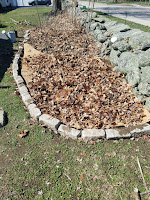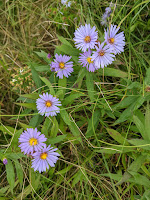Cardboard Use 2
My last blog post sparked some discussion on the Portsmouth Caterpillar Club's Facebook Page including one comment that cardboard is allowed under an organic certification (I assume) as long as the tape and plastics are removed and the coated / water-resistant (pfas) materials are not used. I had a large amount due to my door replacement project from last years so I decided to go ahead and use it to control weeds while trying to maintain the underlying soil health. Here is what I did.
Step 1: I put a layer of maple leaf mulch to block out light and to create an
aeration zone that will sit below the cardboard layer. This will hopefully reduce the impact and risk of suffocating organisms such as worms and insects underneath. It will also provide an interim food source. You can see here I also employed several mulching assistants who inspected and certified my work.
Step 2: I laid down the cardboard and cut it to match the shape of the expanded
wildflower garden. The cardboard covered the entire area in one sheet so I purposefully cut it into sections so that organisms below the cardboard could escape from underneath and into the soil to be added. You can see one of the gaps I cut here.
Step 3: I added a layer of maple leaves on top of the cardboard, again to block light, to absorb moisture in close proximity to the cardboard to help break it down and to maintain a food source for soil organisms.
Step 4: I dumped a layer of the native mineral soil on top of the maple leaf layer. This contains worms and other organisms, notwithstanding the best efforts of my mulching assistants to remove the same. I am leaving this exposed for now until I add a layer of compost from a landscape supplier (Langs). I sorted as best as I could through the native mineral soil to remove roots of lawn but I am sure I was not perfect. By leaving this exposed, I should be able to come back and pick out any greens that remain before adding the mulch. That is important because I don't want competition.
Step 5: I put down some wide stones I saved from a prior gardening life to make a path so I can access the area for planting seedlings, weeding and most
importantly, to take pictures when the bugs start to use this area. This is my plan
for the area, I think it may be overly crowded or ambitious for the space I have. I will likely have to put the lupins and the partride peas in another area and make the end 100% pearly everlasting. In my limited experience, planting larger masses looks better and less cluttered. It also makes a greater volume of forage available for caterpillars which the butterflies and moths will want if they are going to select this site.
Let me know what you think in the comments below or in the Portsmouth Caterpillar Club's facebook page.
All the best. -Justin
Step 1: I put a layer of maple leaf mulch to block out light and to create an
aeration zone that will sit below the cardboard layer. This will hopefully reduce the impact and risk of suffocating organisms such as worms and insects underneath. It will also provide an interim food source. You can see here I also employed several mulching assistants who inspected and certified my work.
Step 2: I laid down the cardboard and cut it to match the shape of the expanded
wildflower garden. The cardboard covered the entire area in one sheet so I purposefully cut it into sections so that organisms below the cardboard could escape from underneath and into the soil to be added. You can see one of the gaps I cut here.
Step 3: I added a layer of maple leaves on top of the cardboard, again to block light, to absorb moisture in close proximity to the cardboard to help break it down and to maintain a food source for soil organisms.
Step 4: I dumped a layer of the native mineral soil on top of the maple leaf layer. This contains worms and other organisms, notwithstanding the best efforts of my mulching assistants to remove the same. I am leaving this exposed for now until I add a layer of compost from a landscape supplier (Langs). I sorted as best as I could through the native mineral soil to remove roots of lawn but I am sure I was not perfect. By leaving this exposed, I should be able to come back and pick out any greens that remain before adding the mulch. That is important because I don't want competition.
Step 5: I put down some wide stones I saved from a prior gardening life to make a path so I can access the area for planting seedlings, weeding and most
for the area, I think it may be overly crowded or ambitious for the space I have. I will likely have to put the lupins and the partride peas in another area and make the end 100% pearly everlasting. In my limited experience, planting larger masses looks better and less cluttered. It also makes a greater volume of forage available for caterpillars which the butterflies and moths will want if they are going to select this site.
Let me know what you think in the comments below or in the Portsmouth Caterpillar Club's facebook page.
All the best. -Justin








Comments
Post a Comment